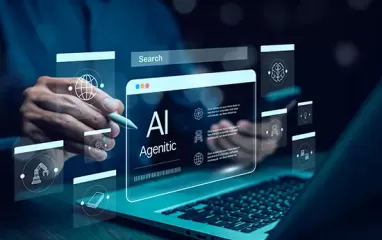Other recent blogs



In the last decade, healthcare has witnessed more revolution and innovation than ever before. But what’s coming next will change the landscape of healthcare forever. The application of Generative AI in healthcare and Agentic AI will transform how care is delivered, how patients interact with the systems, and how vital decision-making is done.
By 2030, healthcare will no longer be defined by longer wait times, irregular records, and rushed consultations. Instead, there will be a much more personalized experience for the stakeholders involved.
Agentic AI vs. Traditional AI
As the healthcare industry evolves, AI plays an increasingly critical role, moving beyond traditional automation to a more advanced and proactive model. While traditional AI focuses on reactive solutions, addressing tasks as they occur, Agentic AI takes it a step further. It anticipates needs, makes intelligent decisions, and integrates smoothly with existing systems, delivering more effective outcomes.
The Four-Step Process of Agentic AI
Situational Awareness
AI agents for healthcare process information from diverse sources, such as sensors, APIs, and databases. It uses this data to build a comprehensive understanding of the current scenario, recognizing patterns and identifying relevant entities.Strategic Reasoning
The system uses LLMs to analyze the collected data, evaluate options, and determine the optimal course of action. This step utilizes techniques like retrieval augmented generation to access proprietary data sources and deliver accurate results.Autonomous Execution
After selecting a strategy, the system autonomously carries out decisions by interfacing with external tools and systems through APIs. It continuously tracks progress, maintains alignment with set goals, and makes real-time adjustments as necessary.Continuos Adaptation
Agentic AI evolves through a continuous feedback loop—often called a “data flywheel”—where data from its interactions is reintegrated to improve its models. This ongoing cycle allows the agent to adapt, learn, and fine-tune its actions over time.
What Makes Agentic AI Different
While generative AI focuses on creating, agentic AI focuses on understanding and executing - taking action. It functions using multiple AI agents powered by Large Language models(LLM) and sophisticated reasoning capabilities. What makes Agentic AI healthcare unique is the ability to set goals, make decisions and take autonomous actions to accomplish them.
Consider a healthcare scenario. When asked to triage a patient’s clinical query, agentic AI goes beyond data analysis and creates a summary of patient’s medical history, but then leverages its intelligence to determine the appropriate care team member and proactively directs the use case to them.
Transformations across healthcare
1. Doctor visits will become smooth: Doctors spend around 40% of their time on documentation. That’s a big time consumption.By 2030:Generative AI tools will summarize key points, and update the patient’s chart in real-time thereby freeing doctors to focus 100% on the patient. The visit becomes less transactional and more human.
2. Your Health will be monitored continuously and intelligently: Agentic AI healthcare solution will transform passive monitoring into an active care process. Your healthcare provider will not only detect anomalies but also determine the action to be taken next.
3. Hyper-Personalized Treatment Plans With Generative AI in Healthcare: Generative AI in healthcare will process and analyze social factors, past treatments, and lifestyle data to generate truly individualized experiences.
E.g., dietary recommendations tied to microbiome data.
There will be a focus on specificity rather than generic advice. Treatments will be tailored to you, not just the diagnosis.
4. Smarter clinical decision making with Generative AI in healthcare: AI will act as a second brain for clinicians. With instant access to billions of data points, AI can:
- Flag rare conditions
- Suggest alternate diagnoses
Example: A rural doctor is unsure about a patient’s symptoms. The AI system reviews global literature, similar case patterns, and clinical guidelines to suggest a rare autoimmune disorder, which the doctor confirms through targeted tests.
5. AI in Preventive Healthcare: Shifting from Sick Care to Well Care: While much of traditional healthcare is reactive—focused on treating illness after symptoms appear—agentic and generative AI can help shift the focus to prevention. By 2030, AI-driven tools will be continuously scanning your wearable data, environmental exposures, and behavioral patterns to predict and prevent potential health risks before they escalate further. For instance, if AI detects a trend in elevated heart rate and poor sleep combined with family history, it may proactively schedule a cardiologist consultation. Such predictive interventions can significantly reduce the burden on healthcare systems and improve patient outcomes by identifying issues early.
6. Enhanced Drug Discovery: Developing a new drug takes years and demand significant investments. Agentic AI fastens this journey by creating sophisticated simulations that predict how various compounds will interact with virtual patients models, including potential effects on body.
These early insights enable researchers to design clinical trials more efficiently and reduce the overall time needed to bring new treatments to patients.
7. Care Coordination and Communication: AI agents in healthcare unify patient data from multiple sources, giving healthcare providers access to comprehensive, real-time medical records. This streamlined data sharing enhances collaboration among specialists, leading to more informed decisions.
8. Patient Empowerment Through AI-Driven Interfaces: By 2030, AI won’t only empower doctors, but it will also empower patients to take care of their health like never before. Personalized healthcare dashboards powered by Generative AI in healthcare will interpret complex medical information in human-friendly language, helping patients better understand their conditions.
This democratization of knowledge and access ensures that healthcare becomes more inclusive and patient-centric.
Strategies for Successful Implementation in Healthcare
Target high-impact automation areas
Start by pinpointing tasks that consume significant resources but contribute minimal value. Routine activities such as scheduling appointments and managing patient intake often slow down productivity and are well-suited for automation.
Identifying these bottlenecks allows you to apply AI where it can drive the most meaningful improvements.
Establish clear guidelines
Clearly define your objectives. Whether you're aiming to shorten wait times or enhance patient satisfaction, set specific and measurable goals with defined timelines. Having a well-outlined roadmap allows you to monitor progress and recognize success.
Structure your data
When patient records are scattered across various platforms, AI's ability to function at its best is limited. Centralizing this data into a unified system enables AI to deliver more accurate insights and support stronger clinical decision-making.
Refine strategy through continuous feedback
Continuously evaluate your Agentic AI healthcare approach, adjusting it in response to real-world results, new technological advances, and changing healthcare priorities.
Conclusion: The Next Era of Care Is Intelligent, Personalized, and Proactive
As we look toward 2030, it’s clear that the integration of generative and agentic AI will reshape healthcare at every level, i.e, from how we diagnose and treat illness to how patients experience care on an everyday basis. No longer will healthcare be defined by fragmented records and administrative loopholes. Rather than that, AI agents in healthcare will enable the system that’s more smarter than previous generations.
Generative AI will take on the heavy lifting of information processing and content creation, while Agentic AI will bring decision-making and autonomous action into the picture. From real-time patient monitoring to faster drug development, the treatment plans in future will be more hyper-personalized.
But success won’t come just like that. Healthcare organizations must invest in data infrastructure, build trust, and set clear goals for implementation. With the right strategy, we are talking about a better healthcare system, not just individual pieces of technology.






